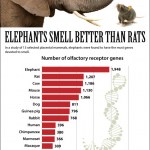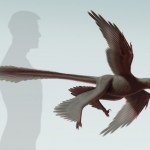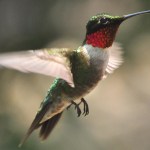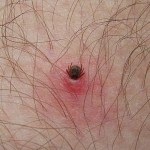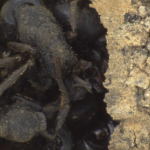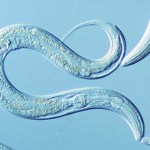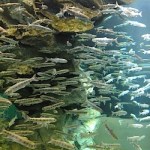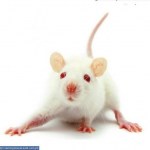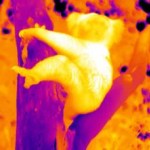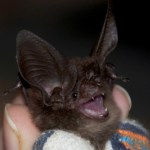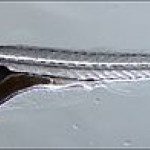Life Science
In honor of the Discovery Channel's "Shark Week", check out these shark cams.
National Aquarium Reef Shark Cam:
Broadcast live streaming video on Ustream
SHARK FIN CAM: Video taken from a camera strapped to the dorsal fin of a shark:
Broadcast live streaming video on Ustream
If you have not yet tuned in to Discovery Channel, there are still a few days left of shark week!
Cartoon image from www.teenwritersblog.com
Physiologist Laurie Goodyear (Joslin Diabetes Center, Harvard Medical School, MA) and her colleagues recently published a study in the American Journal of Physiology that shows how overexpressing a protein can increase exercise capacity. The protein of interest was tribbles homolog 3 (TRB3), which is a mammalian form of the tribbles protein found in fruit flies (aka: Drosophila). Prior to this study, data suggested that TRB3 plays a role in metabolism so Dr. Goodyear's team decided to examine this more closely in skeletal muscle, which is a major…
The cause of "angel wing", a deformity found in waterfowl such as ducks, geese and swans has been uncovered. Sadly, it is often caused by well-intended people feeding birds foods that are too high in proteins or carbohydrates (bread, crackers and popcorn anyone?). Not surprisingly, this condition mainly impacts birds that live in public areas. Because the deformed birds are unable to fly, thousands succumb every year to predators or inclement weather.
Conservationists suggest instead feeding the birds waterfowl feed, duck pellets, sliced seedless grapes, shredded swiss chard and romaine…
Image from CNN.com
Toxoplasma gondii is a parasite found in cat poop that can make both people and cats ill. It can infect any warm-blooded animal, including reportedly 60 million Americans. People infected with T. gondii typically have flu-like symptoms. Dr. David J Bzik in the Department of Microbiology and Immunology at Dartmouth recently said, "We know biologically this parasite has figured out how to stimulate the exact immune responses you want to fight cancer." Cells in the body that are activated by T. gondii include natural killer cells and cytotoxic T cells…
Like Aesop's fable, rats have another reason to be envious of elephants. Elephants also have significantly more genes that can detect different smells (i.e. olfactory receptor genes) than other super-sniffers like rats and dogs. In fact, compared to 13 other species, African elephants have 1,948 genes related to smell putting them ahead of the previous record holder, rats that only have about half as many genes. Primates have much fewer with only 296-396 of these olfactory receptor genes. Interestingly, the common ancestor of mammals had 781 olfactory genes, meaning that primates have lost…
This newly discovered feathered dinosaur, Changyuraptor yangi, was built like a modern airplane. Illustration by S. ABRAMOWICZ, DINOSAUR INSTITUTE, NHM.
Photo of fossil by: Luis Chiappe Dinosaur Institute, NHM as published in the USA Today
The discovery of this non-avian dinosaur, Changyuraptor yangi, that lived 125 million years ago suggests that flight came before birds. The fossil was discovered in the Liaoning Province of northeastern China by Luis Chiappe from the Natural History Museum in Los Angeles, CA. At nearly 4 feet long, it is the largest so-…
Brandy Velten (doctoral student) and Dr. Kenneth Welch (Comparative Physiologist) from the University of Toronto wanted to know whether birds with very different speeds at which they flaps their wings (i.e. wingbeat frequencies) had correspondingly varying types of myosin proteins in their muscles. Their findings were published in the American Journal of Physiology last month.
In their study they compared ruby-throated hummingbirds and zebra finches which reportedly have some of the highest wingbeat frequencies (20-60Hz). As you can imagine, their flight muscles are made up of almost…
Image from the American Physiological Society's website.http://www.the-aps.org/mm/Conferences/APS-Conferences/2014-Conferences/…
Phew!! I just submitted my abstract for the Comparative Physiology meeting that will be held this October. Judging from the preliminary program, it is going to be an exciting meeting!
Here is a description of the meeting from the American Physiological Society's website:
"Comparative physiology takes advantage of the diverse evolutionary histories and ecological settings of animals. By definition, comparative physiology is broad, spanning a variety of animal taxa…
Have you had a chance to see this video from Discovery News showing the flashy 'disco clam'? A graduate student at UC Berkeley, Lindsey Dougherty, unraveled the mystery of this party-like effect. The clams actually have tiny silica spheres (340 nanometers in diameter) on the inside of their lips that reflect light whereas the outside of their lips is devoid of nanospheres. This is a rather unique method to put on a flashy show in the ocean as other creatures of the deep use bioluminescence whereas these clams just unfurl their lips to reflect the ambient light in the ocean around two…
A recent article published in the American Journal of Physiology reviewed how the brain regulates feeding behaviors. Humans are not the only species to eat food in spurts we like to call meals. Research suggests that this behavior may actually aid survival as it reduces exposure time to the environment and makes responding to fluctuations in the availability of food a bit easier to deal with. Dr. Marise Parent and colleagues at Georgia State University wanted to find out how your body determines when to initiate eating as well as how long the interval between meals should be.…
Image of a tick stealing a meal from: www2.outdoorchannel.com
Ticks are blood-sucking arthropods that can act as vectors for various diseases in both animals and humans. A recent article published in Frontiers in Zoology summarizes findings that suggest ticks may also be considered venomous ectoparasites. For example, Ixodes holocyclus is a species of Australian tick whose saliva can induce paralysis in humans and animals. According to the new article, about 8% of known tick species can induce paralysis. Ornithodoros savignyi ticks even secrete a lethal…
Bone-house wasps protect their young by building walls made of ant carcasses. Image from: Merten Ehmig
A new species of spider wasp that protect their young with walls made of ant carcasses has been discovered in the forests of China. Dr. Michael Staab from the University of Freiburg discovered the new species which he named Deuteragenia ossarium meaning "bone-house wasp" since the wasps reminded him of the ossuaries in Europe with structures decorated from human bones.
Sedlec Ossuary in the Czech Republic. Image from Wikipedia.
Similar to the ossuaries, the bone-house wasps use alive…
Image of C. elegans from http://www.easternct.edu/~adams/C.eleganslanding.html
New research published in PLOS Genetics shows that starving C. elegans (Caenorhabditis elegans) during the late larval stage of development when the worms are undergoing tissue growth and formation halts cellular activity at previously unknown checkpoints in their development. These findings show that nutrition is an important cue to signal whether or not the worms should continue on to the next stage of development. Interestingly, the two-week starvation period actually doubled the lifespan of the worms as…
Image of Biwa salmon from the Lake Biwa Museum (http://www.lbm.go.jp/english/exhibits/aquarium.html)
It is not surprising that Biwa salmon (image above), a subspecies of Oncorhyncus masou, do not adapt to seawater very well after having been landlocked in Lake Biwa, Japan for the last 500,000 years or so. Researchers from Hokkaido University and Shiga Prefecture Fishery Experiment Station in Japan wanted to know what caused the salmon to lose their ability to thrive in salt water. In a new paper published in the American Journal of Physiology they compared the…
Shivering is one mechanism by which heat is produced in the body. Heat production is called thermogenesis. Another mechanism is through nonshivering thermogenesis regulated by brown fat (i.e. adipose). This second type of heating mechanism kicks in when we need extra heat production such as a postnatal infant, someone developing a fever, an animal arousing from hibernation, eating, or in the case of the current study, stress.
A recent study published in the American Journal of Physiology provides evidence that during stressful events brown adipose tissue can elevate body temperature through…
Infrared image of a koala (from S. Griffiths)
New research sheds light why koalas (Phascolarctos cinereus) spend so much time hugging trees. As shown in the infrared image above, the trees stay cool on hot days. Since koalas do not sweat, hugging trees is another method to keep their cool in addition to panting and licking their fur. The research also shows that the animals who hug trees lose less water through evaporation that those that do not hug trees.
I think I might need to start hugging trees this summer.
Source:
Briscoe NJ, Handasyde KA, Griffiths SR, Porter WP,…
Image of a big-eared bat from Scientific American
The New Guinea big-eared bat (Pharotis imogene; specimen pictured above) was thought to be extinct for the past 120 years. The bat is now considered critically endangered or possibly extinct as this specimen is the only known member of the genus. Since very little is known of this endangered bat, researchers who identified this specimen suggest that further research is needed to determine its abundance and distribution. With ongoing deforestation in New Guinea, this species may very well actually become extinct.
Source:
www.…
Image of a zebrafish larva from (NHGRI Press Photos).
Calcium is very important for the normal development, growth and survival of most vertebrates. Therefore, regulation of calcium intake and disposal is well-controlled. Mammals obtain most of their calcium from the diet, whereas fish obtain calcium by absorbing it from the external environment. For adults, this occurs in the gills and for larvae it is absorbed through the skin. What this means is that fish living in low calcium environments can acclimate by increasing the absorption of calcium from the water.
Dr. Kwong (Dept. of…
Image of cricket chips called "chirps" from Six Foods. (http://www.sixfoods.com/#product)
Crickets are the first insect to now be farmed for human consumption in the United States. I'll admit the thought of snacking on cricket flour-based chips is not exactly appetizing. But the process of farming insects over more traditional livestock seems to be less wasteful. Insect farming is a more efficient way of producing dietary protein as it takes much less feed and water to raise insects as compared to cattle. In addition, greenhouse gas emissions from crickets are much lower than…


